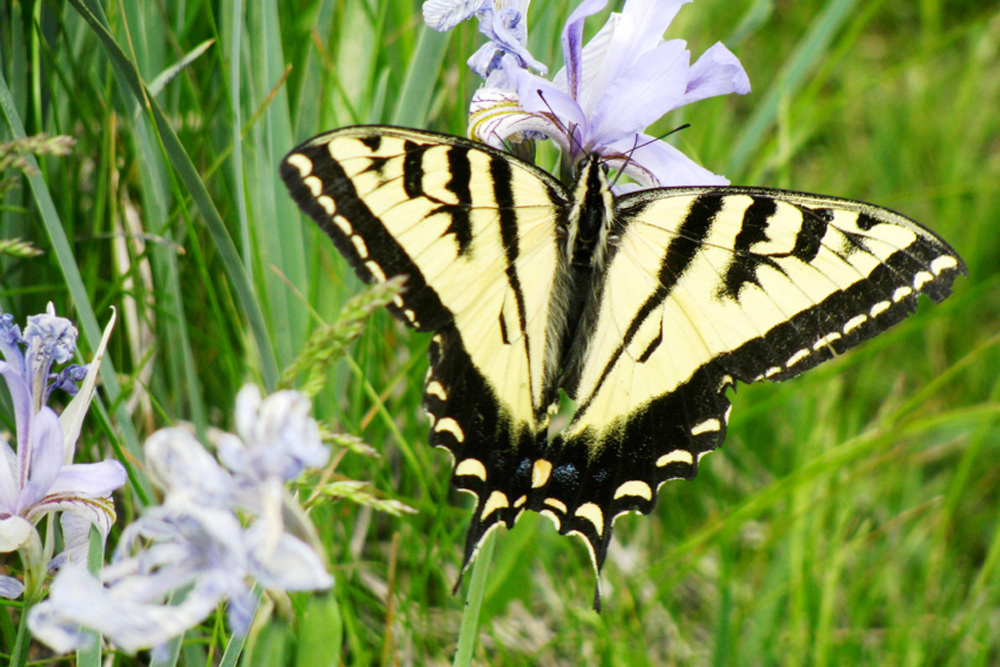In Photos: Beautiful Butterflies of the American Deserts
Signs of spring

By mid-February in the three great hot and dry deserts of the American West, wildflowers turn stark desert landscapes into a sea of color. Whether it is in the low plains of Death Valley or among the saguaro forests of the Sonoran Desert, wildflowers become for a short time the most common of plants, while also signaling the arrival of another spring.
Colorful deserts

Every color of the rainbow can be found across the land which, in another short three months, will return to the drab shades of browns and blacks. But for now, the gold of the California poppy (Eschscholzia californica), or the blue of lupine (Lupinus preens) and the purple of the owl's clover (Castilleja exserta), as shown here, all turn the desert into a magic carpet of natural beauty.
Western Swallowtail

And as surely as the explosion of wildflowers occurs across the desert lands each spring, so too do the many species of butterflies returning to feed upon them. In the Sonoran Desert alone, there are more than 250 species of butterflies found flittering across the desert floor, from one wildflower to another. Here, a Western Swallowtail (Papilio rutulus) enjoys a quick meal of nectar.
American Snout

The American snout (Libytheana carinenta) is a common butterfly of these American deserts. It has an extremely wide distribution from central California to the eastern United States, south through Central America and South America to Argentina. Each spring in the West, there is a mass migration northward of millions of these butterflies. Two generations of butterflies occur each year. The adult wingspan measure 1.6 inches to 1.9 inches (4 to 5 centimeters) and they seem to have a preference for feeding on yellow and white flowers.
Painted Lady butterfly larvae

The return of butterflies to these deserts is soon followed by an explosion of their young caterpillars feeding on the annual crop of desert wildflowers. Shown here is the larvae of the Painted Lady butterfly (Vanessa cardui) as it feeds of the Common Fiddleneck (Amsinckia menziesti) flower in the Sonoran Desert of Arizona.
Painted Lady

The Painted Lady is also known in some parts as the Thistle Butterfly because of its caterpillars' apparent fondness for thistle plants. It is the most widely dispersed butterfly in the world, as it can be found on every continent except Australia and Antarctica. Occasionally a population explosion of the Painted Lady butterfly in the deserts of northern Mexico results in a migration of the butterfly into the far north of Canada.
Gold-hunter's Hairstreak

The Gold-hunter's Hairstreak (Satyrium auretorum) is a common visitor to these southwest deserts. Desert milkweed (Asciepias subulata) is a favorite food of this butterfly, which has a wingspan of 1 inch to 1 1/4 inches (2.5 to 3.2 cm). Hairstreak butterflies belong to the Lycaenidae Family and are part of the true butterfly Superfamily Papilionoidea. There are approximately 4,700 species of this family of butterfly found around the world.
Get the world’s most fascinating discoveries delivered straight to your inbox.
Great Purple Hairstreak

The colorful Great Purple Hairstreak (Atlides halesus) is another member of the Superfamily Papilionoidea found in the deserts of the American West. The Great Purple Hairstreak has one short and one long tail protruding from its hind wing. Adults have a wingspan of 1 1/4 inches to 2 inches (3.2 to 5.1 cm). Mistletoe often found growing on mesquite and palo verde trees of the desert regions are a favorite food of the Hairstreak's caterpillars.
Queen butterfly

The Queen butterfly (Danaus gilippus) is a year-round resident in the deserts of the American West. It is a relative of the Common Monarch (Danaus plexippus), but is darker in color. Adult Queen butterflies have a wingspan of 2 5/8 inches to 3 7/8 inches (6.7 to 9.8 cm). The larvae of the Queen feed on the various species of milkweed that grow throughout the desert. Queen butterflies are found throughout the American deserts and in the southern regions of the United States, south through Mexico, Central and South America to Argentina.
Checkered White

The Checkered White (Pontia protodice) is a commonly found butterfly in the middle and lower elevations of the American deserts. They are most common from March to May but can be found in the warm regions of the desert all year round. A smaller desert butterfly with a wingspan of only 1 1/2 inches to 2 1/2 inches (3.8 to 6.3 cm), Larvae of the Checkered Whites prefer to feed on the flowers, buds and fruits of their host, but will consume leaves when only leaves are available. They dine on the variety of plants from the mustard, cabbage and caper families that grow across the desert regions.
Western Pygmy-Blue

The Western Pygmy-Blue (Brephidium exilis), one of the smallest butterflies in the world, has a wingspan of only 1/2 inch to 3/4 inch (1.2 to 2 cm), and is a common resident of the American deserts. Caterpillars feed on the many species of saltbush found across these desert regions. They are part of the gossamer wing family of butterflies, or those whose wings appear delicate and shimmery because they are covered by both pigmented and light-reflecting scales. These miniature butterflies are found from central California east to Texas and south throughout Baja California, Mexico to Venezuela. Interestingly, the tiny chrysalises of the Western Pygmy-Blue can make a faint noise that lepidopterists think might help scare off hungry ants.


